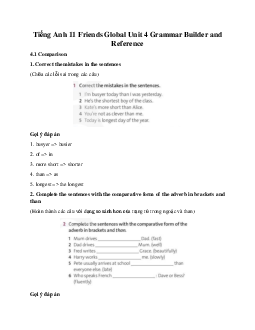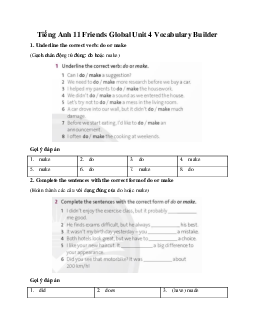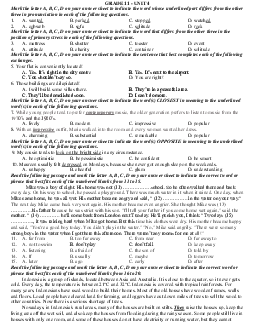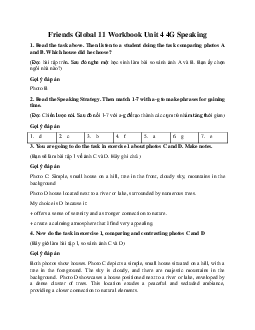





Preview text:
Unit 4 Lớp 11: 4F Reading trang 54, 55 Bài 1
SPEAKING Look at the photos and the titles of texts A-C. What do you think the texts are about?
(Nhìn vào các bức ảnh và tiêu đề của văn bản A-C. Bạn nghĩ gì về các văn bản?)
A. Living sculptures (Tác phẩm điêu khắc sống)
B. The Crazy house (Ngôi nhà điên)
C. Well-contained housing (Nhà ở khép kín) Gợi ý đáp án
Looking at the picture, I guess the texts will give us information about some kind of
special houses in the world. They can be weird, but they will be unique. Bài 2
Quickly read texts A-C and check your ideas.
(Đọc nhanh văn bản A-C và kiểm tra ý tưởng của bạn.) A. Living sculptures
Gregory Kloehn is a sculptor with a difference. Not only are his sculptures created
from bits of rubbish, but each of his unique creations offers a homeless person
somewhere to live. Gregory works in California, where there are a lot of people living
on the streets. Each of his sculptures is no bigger than the average sofa, but the tiny,
one-roomed shelters are as wonderful as mansions for a person who is sleeping rough.
Gregory searches on rubbish dumps to find pieces to use. A washing machine door is
as good as a normal window. A fridge door can make a fine front door, and has useful
shelves on the inside. And each home is on wheels so that it can be pushed around easily. B. The Crazy house
With a view to bringing humans closer to nature, architect Dang Viet Nga created this
surreal artistic guesthouse in Da Lat, Viet Nam. The Crazy House has gained
recognition for its creative and unique architecture. There are almost no straight lines
and no right angles at all. The structure of the house does not follow any rules, but
everything looks harmonious. This weird structure is a maze of winding flights of
stairs, dangerous-looking bridges, and sculptural rooms, each of which is named after
an animal. In one room, guests are watched over by the glowing red eyes of a
kangaroo. In another room, the window looks like the cobweb of a giant spider and
the fireplace is in the form of an eagle's egg.
C. Well-contained housing
If you heard that they were putting homeless people into shipping containers, you
might be shocked. But that's exactly what is happening in Brighton, England. The
Brighton Housing Trust has been inspired by a similar housing estate in the
Netherlands. It is developing 36 studio flats in the town centre, using old shipping
containers. The flats will have a window at each end and a toilet and shower room in
the middle. On one side there'll be a kitchen and small dining table, and on the other
side a living room with a sofa bed. At 24 square metres, they are smaller than a shared
room in a homeless hostel. But they are much more desirable and certainly spacious
enough for one person. They are also stackable. The containers will sit on top of one
another with stairs connecting them. Gợi ý đáp án
The texts are about innovative and creative solutions to social issues, such as
homelessness and affordable housing.
(Các văn bản nói về các giải pháp đổi mới và sáng tạo cho các vấn đề xã hội, chẳng
hạn như tình trạng vô gia cư và nhà ở giá rẻ.) Bài 3
3. Read the Reading Strategy. Match two of the texts with the photos below. Say
what evidence you found to support your answers.
(Đọc Chiến lược đọc. Ghép hai trong số các văn bản với các bức ảnh dưới đây. Nói
những bằng chứng bạn tìm thấy để hỗ trợ câu trả lời của bạn.)
Reading Strategy (Chiến lược đọc)
When you find evidence in the text that supports an answer, underline it and note
which question it refers to. If you do that, you can find it again easily when you are
checking all your answers at the end.
(Khi bạn tìm thấy bằng chứng trong văn bản hỗ trợ câu trả lời, hãy gạch dưới nó và
lưu ý câu hỏi đó đề cập đến. Nếu bạn làm như vậy, bạn có thể tìm lại nó một cách dễ
dàng khi bạn kiểm tra tất cả các câu trả lời của mình vào lúc cuối.) Gợi ý đáp án 1. B 2. C Bài 4
Match the texts (A-C) with the sentences (1-4) below. Make a note of the evidence
you found to support your answers.
(Nối đoạn văn (A-C) với các câu (1-4) bên dưới. Ghi lại bằng chứng bạn tìm thấy để
hỗ trợ câu trả lời của bạn.)
1. The designer of this house wants to raise public awareness of protecting nature.
2. The builder of these homes uses only recycled parts.
3. Each room in this house has a different animal theme.
4. These homes can be put together to make a block of flats. Gợi ý đáp án 1. B 3. B 2. A 4. C Bài 5
VOCABULARY Match a-g with 1-7 to make compound nouns. They are all in the texts.
(Nối a-g với 1-7 để tạo danh từ ghép. Tất cả đều có trong văn bản.) Compound nouns 1. rubbish a. bed 2. sofa b. containers 3. front c. door 4. dining d. dump 5. shipping e. estate 6. housing f. flat 7. studio g. table Gợi ý đáp án
1 - d. rubbish dump: bãi rác
2 - a. sofa bed: giường sofa
3 - c. front door: cửa trước
4 - g. dining table: bàn ăn
5 - b. shipping containers: container chở hàng
6 - e. housing estate: nhà ở
7 - f. studio flat: căn hộ studio Bài 6
Read the texts again. Answer the questions.
(Đọc văn bản một lần nữa. Trả lời các câu hỏi.)
1. Where does Gregory Kloehn find the parts to make his houses?
2. What does Gregory sometimes use as a front door?
3. In what way does staying in the Crazy House bring guests closer to nature?
4. Apart from the UK, in which country have containers been made into flats? Gợi ý đáp án
1. Rubbish dumps. (Bãi rác.)
2. Fridge door. (Cửa tủ lạnh.)
3. By the house's design and architecture.
4. Netherlands. (Hà Lan.) Bài 7
SPEAKING Work in pairs. Discuss these questions
(Làm việc theo cặp. Thảo luận những câu hỏi sau.)
1. Which home is the most original and clever, do you think? Why?
2. Which is the most useful from a social point of view? Why?
3. Which of the homes would you like to live in? Why?
4. Which of the homes would you not like to live in? Why not?




